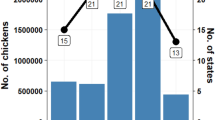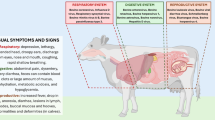Abstract
Background
Enteroviruses (EVs) are a genetically and antigenically diverse group of viruses infecting humans and a variety of animals including non-human primates (NHPs). The present study was to investigate EVs in the fecal samples from captive NHPs in zoos in China using classic RT-PCR and viral metagenomics methods.
Findings
An EV strain was detected in a fecal sample collected from a captive NHP of a zoo in eastern China. The complete genome of this EV strain (named Sev-nj1) was determined and characterized. Sequence analysis indicated Sev-nj1 shared the highest sequence identity (75.6 %) with an EV-J strain, Poo-1, based on the complete genome. Phylogenetic analysis showed Sev-nj1 clustered with the other EV-J strains, forming a separate clade.
Discussion
According to the genetic distance-based criteria, Sev-nj1 belonged to a new type within the species EV-J. This is the first study detecting EV-J from a NHP in China, which will be helpful for the future epidemiology study of EVs in NHPs.
Similar content being viewed by others
Background
Enteroviruses (EVs) are members of the genus Enterovirus within the family Picornaviridae and are divided into more than 300 types to date (Van Nguyen et al. 2014). EVs infect many mammals, including humans, NHP, cattle, sheep, dog, horse, deer and pig (Van Nguyen et al. 2014; Sadeuh-Mba et al. 2014). EVs are currently classified into twelve species (labeled as EV-A—EV-H, EV-J, RhinovirusA-C) according to the sequence divergence, host range, similarities in replication and a generally observed restriction of recombination (Van Nguyen et al. 2014). Genetic identification displayed that some simian EVs isolates were similar to human viruses (e.g., EV-A, EV-B and EV-D), while others were genetically different and now divided into two separate species (e.g., EV-H and EV-J) (Van Nguyen et al. 2014; Sadeuh-Mba et al. 2014; Oberste et al. 2007, 2008, 2013a, b). Although EVs have prevalence in NHP group, whether they are associated with disease in monkeys are unclear (Van Nguyen et al. 2014; Oberste et al. 2007, 2013a, b; Nix et al. 2008).
EVs are small non-enveloped viruses having a capsid with isosahedral symmetry, whose genome is made up of a single poly-adenylated positive RNA strand with 7.5 kb in length (Larkin et al. 2007). The single open-reading frame (ORF) of EVs is flanked by two untranslated regions (5′UTR and 3′UTR), which can be translated into a polyprotein of 2200 amino acids (aa) and further processed by viral proteases into structural (VP4, VP2, VP3, and VP1) and non-structural (2A, 2B, 2C, 3A, 3B, 3C, and 3D) proteins (Piralla et al. 2013; Tang et al. 2014).
To date there are only six whole genome sequences of EV-J from samples collected from US (Oberste et al. 2002, 2007). EV-J has never been reported in China. In this study, we determined the complete genome sequence of a simian enterovirus and compared the sequence with those of EV reference strains.
Methods
Specimen collection
Totally, 69 fecal specimens were collected from rhesus (n = 10) and pigtailed macaques (n = 25), sooty mangabey (n = 21), and chimpanzee (n = 13), all of which are healthy and captive in three zoos in eastern China. These samples were shipped, frozen, to our laboratory and stored at −70 °C prior to analysis.
Enterovirus identification by RT-PCR and sequencing
RNA were extraced from 200 μl of stool suspensions using the TaKaRa MiniBEST Viral RNA/DNA Extraction Kit according to the manufacturer’s instructions (TaKaRa).
Extracted RNA was tested for enterovirus (EV) by one-step Reverse transcriptase PCR (RT-PCR) assay targeting the 5′ untranslated regions as previous described (Van Nguyen et al. 2014; Oberste et al. 2003). Enterovirus complete genome was amplified by RT-nested PCR with primers designed based on the closely related EV strains (FJ007373, AF326766, AF414373 and AF414372) available in GenBank. PCR products were separated and visualized on an agarose gel, and purified by using the gel extraction kit. The resulting DNA templates were sequenced by sanger sequencing method in Sangon Sequencing company (Shanghai, China).
Viral metagenomics method was also used to identify viral sequences in these samples, the methods as previous described (Yang et al. 2016). Six separate pools were randomly generated. After low speed centrifugation and filtration the samples were treated with DNase and RNase. Six libraries were then constructed using Nextera XT DNA Sample Preparation Kit (Illumina) and sequenced using the Miseq Illumina platform with 250 bases paired ends with a distinct molecular tag for each pool.
Phylogenetic analysis
Phylogenetic trees were constructed based on the EVs’ VP1, 3D and complete genome nucleotide sequences in the present study and representative members of EVs. Sequence alignment was performed with the default settings in CLUSTAL W software (Larkin et al. 2007). Phylogenetic trees with 100 bootstrap resamples of the alignment data sets were established using the neighbor-joining method in MEGA.5.0 (Tamura et al. 2011). Bootstrap values (based on 1000 replicates) for each node are given. Putative ORFs in the genome were predicted by NCBI ORF finder.
Nucleotide sequences
The sequence described here has been deposited in the GenBank database, with GenBank accession no. KT581587 and strain name Sev-nj1.
Results and discussion
Our RT-PCR and Viral metagenomics detecting results indicated that one fecal sample from rhesus was positive for EVs. The positive rate is 1.45 % (1/69) and significantly lower than those of other research, e.g., Dung reported extremely high frequencies of active infection (95 %) among wild mandrills and other Old World monkey (Van Nguyen et al. 2014), which might be owing to the small sample number, the zoo’s clean environment and stricter monitoring system.
To investigate the relationship between Sev-nj1 and the other simian EVs, the complete genome of Sev-nj1 was determined. The genome length of the Sev-nj1 is 7298 nt. The genomes had a typical enterovirus organization, with a coding region of 2178 codons translated into four structural (VP4, VP2, VP3 and VP1) and seven non-structural proteins (2A, 2B, 2C, 3A, 3B, 3C and 3D) (Piralla et al. 2013; Tang et al. 2014).
Sequence analysis based on the whole genome indicated that Sev-nj1 showed the highest sequence similarity with strain POo-1 EV-J103, which was isolated from captive primate (Oberste et al. 2007), suggesting Sev-nj1 belongs to species of EV-J. The VP1 region of Sev-nj1 shared 67–74 % nt and 54–82 % aa identity with other strains of EV-J including EV-J108, EV-J103, SV6 and EV-J121. The other two types of EV-J, EV-J112 and EV-J115, only have 27 partial VP1 sequences (about 300 bp) (GenBank nos.: JX537988-JX538004, JX537976-JX537984, and JX538005). Based on the 300 bp sequence, Sev-nj1 shared 64–70 % sequence identities with those 27 sequences of EV-J115 and EV-J112, suggesting Sev-nj1 is genetically distant from them. Brown et al. suggested that the nucleotide identity in ‘grey zone’ of 70–75 % VP1 nt, a more stringent value of 88 % VP1 amino acid identity is more appropriate for routine typing (Brown et al. 2009). The VP1-coding sequence of Sev-nj1 showed 74 % nt and 82 % aa similarity with the EV-J103 Poo-1 strain, suggesting Sev-nj1 belongs to a new type.
To further elucidate the genetic relationship of Sev-nj1 with other siman EV types, phylogenetic trees were constructed based on the complete genome, VP1 and 3D regions, respectively. The virus strains in phylogenetic analysis included Sev-nj1 in the current study and the siman EV prototype strains available in the GenBank database (Fig. 1). As expected, our results indicated strain Sev-nj1 belonged to EV-J and formed a lineage with the EV-Poo-1 strain in the trees over the complete genome, VP1 and 3D regions, with a bootstrap value of 100 % (Fig. 1), which confirmed the preliminary molecular typing results. Taken together, we identified one simian enterovirus in one captive rhesus, which showed the closest relationship with a simian EV-J103 strain. Our results showed there were no detections of known human enteroviruses in NHP, indicating that human-to-primate transmission didn’t occur during the study period.
In conclusion, this is the first study identifying EV-J from a captive primate in China. Sev-nj1 is most genetically related to Ev-Poo-1, an EV-J strain isolated from pigtail macaque.
References
Brown BA et al (2009) Resolving ambiguities in genetic typing of human enterovirus species C clinical isolates and identification of enterovirus 96, 99 and 102. J Gen Virol 90(Pt 7):1713–1723
Larkin MA et al (2007) Clustal W and Clustal X version 2.0. Bioinformatics 23(21):2947–2948
Nix WA et al (2008) Identification of enteroviruses in naturally infected captive primates. J Clin Microbiol 46(9):2874–2878
Oberste MS, Maher K, Pallansch MA (2002) Molecular phylogeny and proposed classification of the simian picornaviruses. J Virol 76(3):1244–1251
Oberste MS, Maher K, Pallansch MA (2003) Genomic evidence that simian virus 2 and six other simian picornaviruses represent a new genus in Picornaviridae. Virology 314(1):283–293
Oberste MS, Maher K, Pallansch MA (2007) Complete genome sequences for nine simian enteroviruses. J Gen Virol 88(Pt 12):3360–3372
Oberste MS et al (2008) The complete genome sequences for three simian enteroviruses isolated from captive primates. Arch Virol 153(11):2117–2122
Oberste MS et al (2013a) Characterizing the picornavirus landscape among synanthropic nonhuman primates in Bangladesh, 2007 to 2008. J Virol 87(1):558–571
Oberste MS et al (2013b) Naturally acquired picornavirus infections in primates at the Dhaka zoo. J Virol 87(1):572–580
Piralla A et al (2013) Genome characterisation of enteroviruses 117 and 118: a new group within human enterovirus species C. PLoS One 8(4):e60641
Sadeuh-Mba SA et al (2014) Characterization of enteroviruses from non-human primates in cameroon revealed virus types widespread in humans along with candidate new types and species. PLoS Negl Trop Dis 8(7):e3052
Tamura K et al (2011) MEGA5: molecular evolutionary genetics analysis using maximum likelihood, evolutionary distance, and maximum parsimony methods. Mol Biol Evol 28(10):2731–2739
Tang J et al (2014) Complete genome characterization of a novel enterovirus type EV-B106 isolated in China, 2012. Sci Rep 4:4255
Van Nguyen D et al (2014) High rates of infection with novel enterovirus variants in wild populations of mandrills and other old world monkey species. J Virol 88(11):5967–5976
Yang S et al (2016) Bufavirus Protoparvovirus in feces of wild rats in China. Virus Genes 52(1):130–133
Authors’ contributions
XW carried out all sample manipulations, nucleic acid extraction, amplification, and preparation for sequencing and drafted the manuscript. SS, HW, QS, SY participated in design of the study. WZ oversaw all sequence data generation, participated in design of the study and and helped to draft the manuscript. All authors read and approved the final manuscript.
Acknowledgements
This work was partly supported by the Postdoctoral Fund of Jiangsu Province No. 1501110B, Open Fund from the Key Laboratory of Laboratory Medicine of Jiangsu Province No. JSKLM-2014-019, the National Natural Sciences Foundation of China No. 31302107, the Natural Science Foundation of Jiangsu Province No. BK20130542, and the China Postdoctoral Special Science Foundation No. 2015T80503.
Competing interests
The authors declare that they have no competing interests.
Ethical approval
Ethical approval was given by the Ethics Committee of Jiangsu University with the reference number as P3658.
Author information
Authors and Affiliations
Corresponding author
Rights and permissions
Open Access This article is distributed under the terms of the Creative Commons Attribution 4.0 International License (http://creativecommons.org/licenses/by/4.0/), which permits unrestricted use, distribution, and reproduction in any medium, provided you give appropriate credit to the original author(s) and the source, provide a link to the Creative Commons license, and indicate if changes were made.
About this article
Cite this article
Wang, X., Shao, S., Wang, H. et al. An enterovirus from a captive primate in China. SpringerPlus 5, 1281 (2016). https://doi.org/10.1186/s40064-016-2966-y
Received:
Accepted:
Published:
DOI: https://doi.org/10.1186/s40064-016-2966-y





